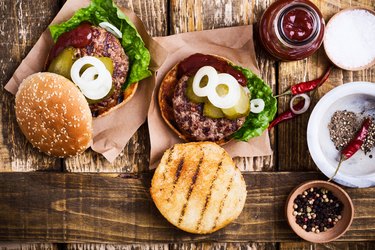
Few foods are as comforting and satisfying as a juicy burger. Cooking a medium-rare burger, though, may not be safe for your health. Ground meat is more prone to bacterial contamination and may cause foodborne illnesses.
Grilling Medium-Rare Hamburgers
Video of the Day
For many people, cooking a medium-rare hamburger is the only way to make a burger juicy and delicious. Unfortunately, ground beef (even more so than steaks) is more likely to be contaminated with E. coli, warns the U.S. Food and Drug Administration.
Video of the Day
Symptoms of bacterial contamination include digestive discomfort, diarrhea, stomach cramps and vomiting. You may also notice blood in the stool. An infection can be fatal in vulnerable populations.
Ground beef carries these risks because the meat goes through a lot of processing during production, packing and handling. This food product is often made from multiple cattle and the grinding process allows bacteria to quickly spread between batches.
The USDA Food Safety and Inspection Service recommends that ground beef be cooked until its internal temperature reaches 160 F to safely kill foodborne contaminants. A medium-rare burger served at below 145 F is inadequately cooked.
These guidelines are particularly important for pregnant women, young children and people with compromised immunity as they' re at greater risk of complications from foodborne illnesses.
Burger Grilling Tips
Just because you're cooking your burger to medium rare doesn't mean you have to settle for dry, unpalatable meat. The Centers for Disease Control and Prevention offers some tips on how to keep your burgers juicy and flavorful even when cooking them to the appropriate level of doneness.
Read more: The 10 Best Homemade Veggie Burger Recipes
First, keep the ground beef refrigerated until you're ready to form the patties. Next, put the patties back in the fridge until you're ready to transfer them to the preheated grill. Note: when the patties chill for at least 30 minutes prior to cooking, they're more likely to keep their round burger shape.
Test the internal temperature using a meat thermometer and remove the patties when they reach 160 F. Let them rest on a fresh, clean plate for about five minutes.
Keep the cooked burgers away from any utensils and plates that touched raw meat. Mixing cooked and raw meat increases the chance of contamination with E. coli or other bacteria.
Once you're done cooking, clean the grill. Scrub off any meat bits as this helps kill any bacteria that may be lingering, advises the Academy of Nutrition and Dietetics.
Cook Your Burgers to Perfection
Regardless of what grilling temperature you use, there are specific techniques for cooking your meat to perfection.
Coat the grill racks with vegetable oil to keep food from sticking. After the grill has had a chance to heat up for 10 to 15 minutes, add the burgers. Make sure you have at least a three-quarter-inch space between each patty to prevent steaming, recommends Utah State University Extension.
Season burgers at the last minute — just before cooking. Salt, pepper and maybe some spices will do. Season one side and place it on the grill first so the seasoning sears into the meat. Flip your burgers just once during cooking to create an adequate sear on the outside.
Walk away from your burgers as they cook. It's tempting to push them down, thinking you're distributing heat, but this only squeezes out the juices that make burgers so tasty. For inspiration, check out our Protein Turkey Burger recipe or our delicious Lean Burger With Avocado. The flavor is out of this world!
- USDA Food Safety and Inspection Service: "Safe Minimum Internal Temperature"
- Academy of Nutrition and Dietetics: "Clean Grilling"
- University of Illinois Extension: "Meat Temperature"
- Utah State University Extension: "Grilling and Broiling"
- Centers for Disease Control and Prevention: "E. coli"
- U.S. Food and Drug Administration: "Escherichia coli (E. coli)"
- Centers for Disease Control and Prevention: "Restaurant Ground Beef Handling and Cooking"